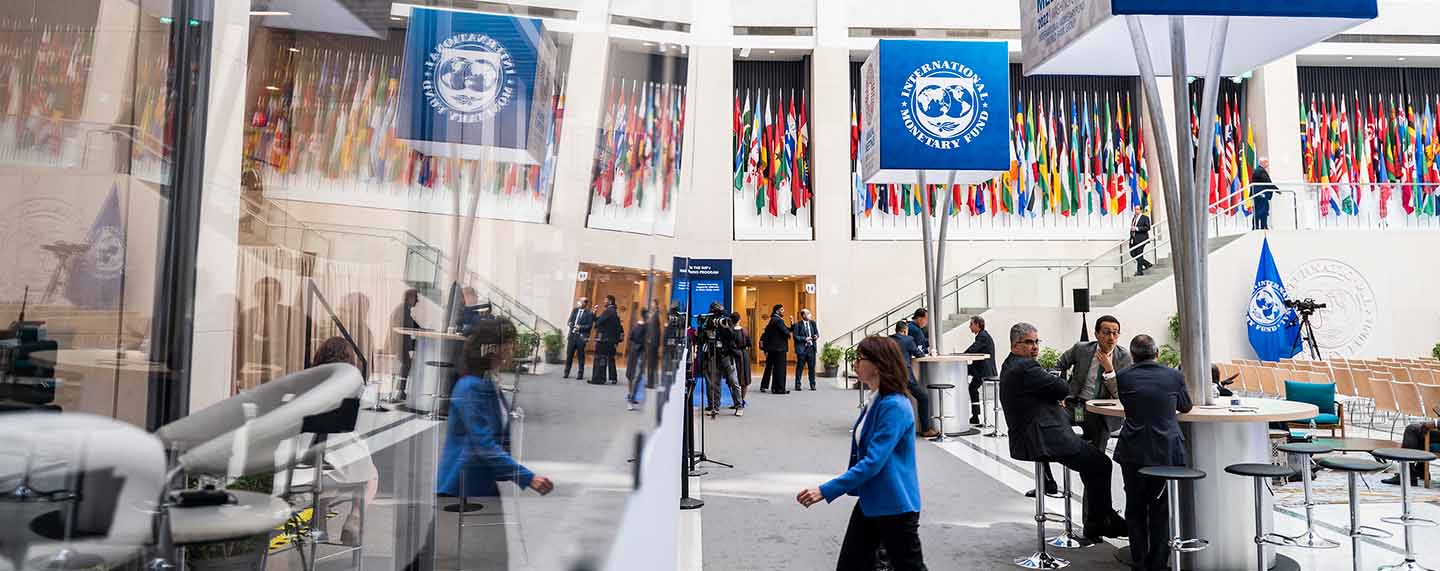Theme[1]
Four critical developments in the global economy with profound implications require urgent changes at the IMF: (1) the increasing relevance of the global demand for liquid assets evident in recent crises, with the concomitant fragilities that this brings about, eg, global liquidity shocks; (2) record levels of sovereign debt with important increases in domestic debt; (3) the emergence of new official bilateral creditors with a significant presence in emerging market and developing economies (EMDEs); and (4) a significant erosion in the credibility of the IMF’s programmes.
Summary
This analysis advances three broad proposals to address these issues by: (1) creating an Emerging Markets Fund (EMF); (2) modifying the G20 Common Framework to effectively differentiate across debt classes in EMDE debt restructurings; and (3) empowering the IMF to refinance outstanding debts from failed programmes.
Analysis
Accidents can happen in imperfect international financial markets and lead to contagion, adversely affecting countries with sound fundamentals. Lenders of last resort in advanced economies can effectively reduce the severity and duration of these adverse impacts by issuing their own reserve currency, but this is not possible for EMDEs.
EMDEs must, therefore, rely on reserve money created by advanced economies. This calls for adequate foreign reserves’ accumulation and/or ex-ante liquidity lines such as the IMF’s Contingent Credit Lines, facilities that are employed by a limited number of countries.
International liquidity provision for EMDEs
The IMF can reduce this asymmetry by managing an EMF that performs the functions of an international lender of last resort, enhancing the liquidity of emerging markets’ sovereign external debt when international capital market disruptions unduly hit their economies.
Inspired by the institutional innovations created in the EU to address financial contagion (such as the European Central Bank’s Transmission Protection Instrument created in 2022) our proposal is to set up an EMF aimed at reducing the contagion that might be triggered by turbulence in international capital markets. In a systemic event, the EMF’s role would be ‘to counter disorderly market dynamics that are not warranted by emerging markets’ fundamentals’.
Operationally, the EMF would be authorised to make temporary secondary market purchases of sovereign debt of a group of emerging markets countries subject to contagion or, alternatively, purchases of an emerging markets’ bond index such as the Emerging Market Bond Global Diversified Index (EMBIGD) if contagion spreads to many countries.
By creating an instrument that avoids systemic crises, the EMF would contribute to the financial stability of all EMDEs, not only those emerging markets with greater access to the international capital markets. To effectively fulfil its mission, the EMF should be managed by the IMF but segregated from its balance sheet.
The EMF’s rules of intervention and decision making should be clear but flexible, and its board should be prepared to act on short notice during periods of systemic stress. These decisions would normally involve judgement calls, requiring strong governance.
Adequately funding the EMF would require around US$300 billion, equivalent to the outstanding stock of emerging market sovereign short-term international bond debt (approximately equal to 20% of the outstanding stock of total emerging market sovereign international bond debt).
This relatively small amount of funding could be engineered by the advanced economies’ central banks that issue reserve currency by committing swap lines with the EMF, thus avoiding the unnecessary pain imposed on EMDEs in times of international capital market disruptions.
The creation of the EMF would introduce a trade-off between the benefit of tackling sudden stops by providing liquidity and the cost of the moral hazard distortion that results from providing a put option that induces creditors to incur excessive risk-taking in emerging market assets. This trade-off is complex, because the forward-looking nature of capital markets implies that the put option may induce foreign investors to always take larger emerging market positions than otherwise, and not only during episodes of financial distress. This, in turn, induces general overpricing of emerging market assets.
To mitigate these put-option effects, the EMF’s interventions must be made contingent on metrics indicating that the probability of a systemic sudden stop of capital inflows is rising (eg, high leverage ratios, large real appreciations and large current account deficits). This would help to ensure that the benefit of preventing impending sudden stops outweighs the put-option distortions.
Keeping the EMF inactive at times when the probability of sudden stops is low would significantly weaken those distortions. The EMF would need to be vigilant to recognise situations where overall liquidity problems reflect fundamental insolvency across the emerging market asset class. In addition, IMF Article IV monitoring should pay special attention to policy time consistency.
Public debt restructuring
Debt-to-GDP ratios in EMDEs have reached historically record levels due in part to the necessary government responses to the COVID-19 pandemic and in part to pre-existing fiscal weaknesses. A string of debt restructurings is currently underway across EMDEs (for instance Ghana, Zambia, Sri Lanka and Ethiopia). A salient feature of these processes is that they are expected to take place under the G20 Common Framework, a framework that has not worked.
There are two main reasons why the G20 Common Framework has failed so far. First, in recent years the role of new bilateral official creditors –in particular, China and Gulf Cooperation Council countries– has increased significantly, while much of their lending to EMDEs exhibits less explicit conditionality than the lending of multilateral institutions. In the case of China, lending to EMDEs has been generally against collateral and has included non-disclosure clauses, complicating the fulfilment of the G20 Common Framework. Calls for China to participate in collective schemes to restructure bilateral debts are essential in the current context.
Secondly, the G20 Common Framework calls for including domestic debt in restructurings, along with external debt. We disagree. Domestic debt should be excluded from the G20 Common Framework and treated separately, on a case-by-case basis, with different rules depending on the specifics of each country and the composition of domestic debt holders.
There are three main arguments in favour of this case-by-case differential treatment. First, there are enormous legal complexities in mixing domestic and external jurisdictions. Secondly, there is the obvious fact that the holders of local-currency-denominated debt are exposed to dilution via inflation whereas the holders of hard-currency-denominated debt are not. Third, the political, social, and financial system implications of domestic debt restructuring are markedly different than those of external debt restructuring.
Regarding the last argument, while restructuring external debts contributes to reducing a country’s debt overhang and restoring sustainability, restructuring domestic debt may not necessarily do the same. For instance, if the bulk of the domestic debt were held by banks, the government might be compelled to recapitalize the banking system to avoid a banking crisis.
Differential treatment between domestic and external debt may generate moral hazard and induce banks to buy more public debt. Therefore, it is necessary to limit undue exposure of banks to the public sector by appropriate regulation.
In many EMDEs the bulk of the domestic debt is held by pension funds that have been an essential factor in the development of the domestic capital market. In addition, restructuring domestic debt would involve confiscating the assets of future retirees held by the pension funds, which may be socially and politically unacceptable.
Refinancing debt to the IMF
In failed programmes, IMF lending has two main objectives. First, it provides financing to countries that experience balance-of-payments crises and/or fiscal stress –although alleviating fiscal stress per se is not a stated objective of IMF lending but often a de facto one–. Secondly, by negotiating programme conditionality with member countries, the IMF not only seeks to ensure repayment but also provides an implicit endorsement of the policy framework of the country receiving financing. Such an endorsement –sometimes referred to as a ‘seal of approval’– is important in strengthening policy credibility and contributes to reducing the cost of financing and regaining market access. In the case of a failed programme –such as the case of Argentina– the IMF faces a hard choice. To refinance an existing loan, the IMF may be forced to accept a bad programme and be excessively lenient in providing successive waivers for non-compliance with programme targets. Otherwise, if a new programme is not agreed, it has no option but to force the debtor country into arrears with the IMF. Both alternatives are far from optimal.
The former erodes the IMF’s credibility while the latter is a sort of ‘nuclear option’ that can greatly exacerbate economic instability and may lead to social and political unrest. To allow the refinancing of a failed loan without forcing the IMF into weak or inconsistent programmes, failed programme-related loans should be refinanced with an interest rate surcharge but without requiring an IMF programme.
The IMF should be empowered with the ability to refinance, for one time, an outstanding failed programme-related loan at, say, a 10-year maturity without a new programme. The interest surcharge represents a cost to the debtor country but also an incentive to negotiate a new and adequate programme. When a new programme is agreed upon, the interest rate surcharge should be waived.
Introducing this change in the lending policies of the IMF would protect the credibility of IMF programmes and make the relationship with the debtor country more transparent. Restructuring of failed programmes would be managed more efficiently by a new department within the IMF or by a new division within a department not directly involved in lending operations, such as the legal department. Such a department or division would also have the task of coordinating the restructuring with other official bilateral creditors to better protect the IMF’s preferred creditor status.
[1] Statement 46 of the Latin American Committee on Macroeconomic and Financial Issues (CLAAF).




